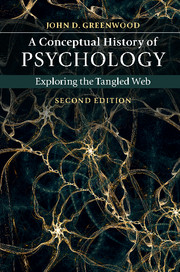Book contents
- Frontmatter
- Contents
- Preface
- 1 History, science, and psychology
- 2 Ancient Greek science and psychology
- 3 Rome and the medieval period
- 4 The scientific revolution
- 5 The Newtonian psychologists
- 6 Physiology and psychology
- 7 Theories of evolution
- 8 Psychology in Germany
- 9 Psychology in America: the early years
- 10 Functionalism, behaviorism, and mental testing
- 11 Neobehaviorism, radical behaviorism, and problems of behaviorism
- 12 The cognitive revolution
- 13 Abnormal and clinical psychology
- Epilogue: the past and future of scientific psychology
- Index
- References
11 - Neobehaviorism, radical behaviorism, and problems of behaviorism
Published online by Cambridge University Press: 05 September 2015
- Frontmatter
- Contents
- Preface
- 1 History, science, and psychology
- 2 Ancient Greek science and psychology
- 3 Rome and the medieval period
- 4 The scientific revolution
- 5 The Newtonian psychologists
- 6 Physiology and psychology
- 7 Theories of evolution
- 8 Psychology in Germany
- 9 Psychology in America: the early years
- 10 Functionalism, behaviorism, and mental testing
- 11 Neobehaviorism, radical behaviorism, and problems of behaviorism
- 12 The cognitive revolution
- 13 Abnormal and clinical psychology
- Epilogue: the past and future of scientific psychology
- Index
- References
Summary
While many psychologists accepted Watson's rhetoric of prediction and control, few accepted the theoretical details of his behaviorist system, and in the 1930s and 1940s, the neobehaviorism of Clark L. Hull (1884–1952) and Edward C. Tolman (1866–1959) superseded Watson's positivist brand of behaviorism. Hull and Tolman followed Watson in maintaining that scientific psychology should be directed to the explanation, prediction, and control of observable behavior rather than introspected mental states, and they rejected the form of structural psychology championed by Titchener and his followers. Yet in contrast to Watson, they recognized the legitimacy of theoretical explanations of observable behavior in terms of the internal states of organisms, including their mental states, on a par with theoretical explanations of the observable properties of physical elements in terms of their internal composition and structure (such as the explanation of the properties of carbon in terms of its molecular composition and structure).
The neobehaviorist attempt to approximate the theoretical orientation of the natural sciences more closely marked an advance over Watson's restriction of behaviorist psychology to the description of observable stimulus–response sequences. However, in their attempt to model behaviorist psychology upon the natural sciences, neobehaviorists did not look to the actual practice of natural sciences such as physics and chemistry, but adopted the equally restrictive logical positivist account of theory advanced by philosophers of science in the early decades of the twentieth century. As Sigmund Koch put it:
In pursuit of these ends, psychology did not go directly to physics, but turned instead for its directives to middlemen. These were, for the most part, philosophers of science (especially logical positivists) and a number of physical scientists who had been codifying a synoptic view of the nature of science and who, by the early thirties, were actively exporting that view from their specialties in the scholarly community at large.(Koch, 1964, p. 10)
The logical positivist account of theory exercised a debilitating influence on the development of neobehaviorist theory. Burrhus F. Skinner 411(1904–1990) exploited the limitations of this account of theory and developed a radical behaviorism that eschewed theories about the internal states of organisms.
- Type
- Chapter
- Information
- A Conceptual History of PsychologyExploring the Tangled Web, pp. 410 - 453Publisher: Cambridge University PressPrint publication year: 2015



